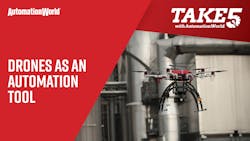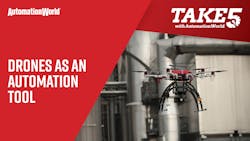
Quick hits:
- Learn how drones can be used to collect data for Industrial Internet of Things applications.
- How artificial intelligence algorithms onboard drones can be used for anomaly detection and pattern recognition.
- Applying modeling software to photos taken by a drone can be used to help in the design, construction, and operations of manufacturing facilities.
- Automation is being incorporated into drones for battery and payload changes as well as automated takeoffs and landings.
- Automation World Feature: Industrial Drones Take Flight
- Video: Artificial Intelligence Drives New Industrial Inspection Drones
- Drones and Industry 4.0
- Visit Packaging & Processing Women's Leadership Network to learn how this program is dedicated to advancing women's careers in the industry.
I’m David Greenfield, Director of Content at Automation World, and thanks for joining me for this Take Five with Automation World episode where I’ll be looking at the use of drones as an industrial automation tool.
So, you’re first thought is likely: What do drones have to do with automation? And that’s a reasonable question considering that drones are not typically seen as a direct part of the sense-decide-act control loop in which almost all automation technologies tend to fit. But if you think of drones as a sensing tool, you can begin to see how they could play a big role in automation.
So, the first thing to understand is how drones can be used as data collectors. And it’s not hard to understand this when you realize that industrial drones are typically outfitted with an onboard computer, multiple sensors, GPS positioning, accelerometers and high-definition cameras. With all this technology onboard, it’s easy to see how drones can fit into the industrial internet of things concept and contribute to the aggregation of data—which is at the core of any IIoT project.
In a column written for Automation World, Chris Corfield of system integration firm Control Techniques, explained how drones can also be seen as a safety device for industrial companies. As he noted in his column, why would you send a human up a tower or other difficult-to-access area to assess a fault when it takes a camera-equipped drone 10 seconds to get there? Also, when using drones as a sensing device, they can be deployed as a thermal-imaging sensor to track high levels of heat coming from an area in a factory and notify workers and emergency services, as well as autonomously activate the sprinkler system, if necessary.
One technology company focusing on the use drones to collect industrial data is Digital Aerolus, an artificial intelligence and autonomy-focused business that also makes the Aertos drones. Because industrial inspection typically involves being able to access hard to reach places in plants that typically have a lot of metal that can interfere with communications—these drones have been designed to fly without the use of any external sensors, such as a GPS, a magnetometer, or optical flow. And the Aertos drones are made of carbon fiber so they can bump into walls without negatively affecting their operation or getting damaged. The company says its drones are currently being used in the oil and gas, warehousing, energy, and underground mining industries.
Bentley Systems is an industrial software company that’s been combining drones with its software for years now to help with facility design. For example, in the past, measuring out a production line to see if new equipment would fit required 3D laser scanner technology to create a point cloud for coordinating the space. Bentley uses its ContextCapture reality modeling software to turn photos taken by a drone into geo-referenced 3D models that include context for design, construction, and operations decisions.
Drone suppliers are also adopting automation to streamline the use of their products. Airobotics, for example, offers a drone with robotic arms that can change the drone’s batteries and install different payloads…such as cameras and other sensors. They also have software for extracting the data gathered by the drone for analysis. Airobotics says that every aspect of its drones’ operation is automated—from programming flight paths to takeoff and landing. Because of this, the company says these drones can run in the background collecting data without any human intervention.
So, I hope you enjoyed this Take Five with Automation World episode. And please keep watching this space for new episodes each week to help keep you on top of what’s happening in the world of industrial automation.
